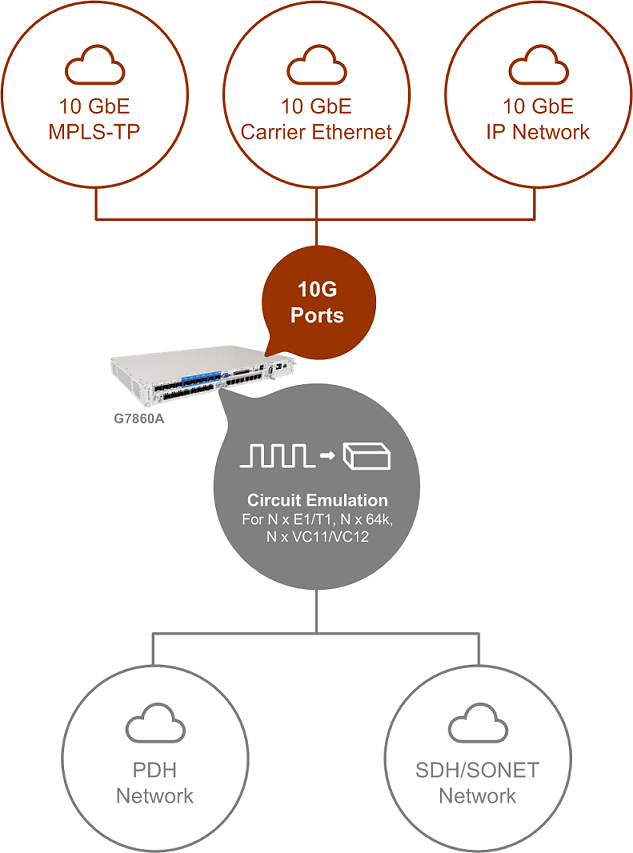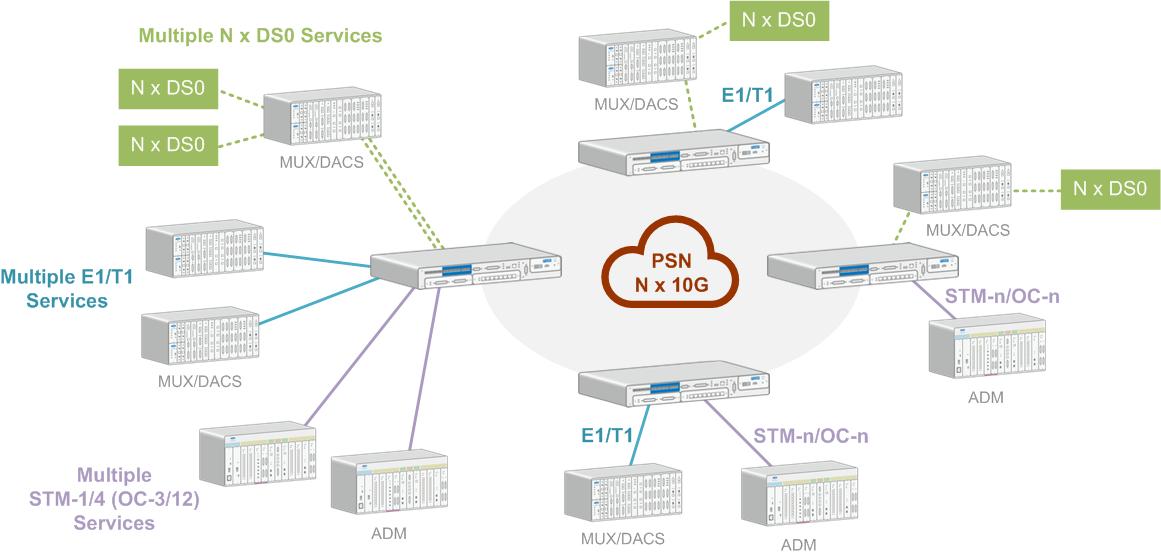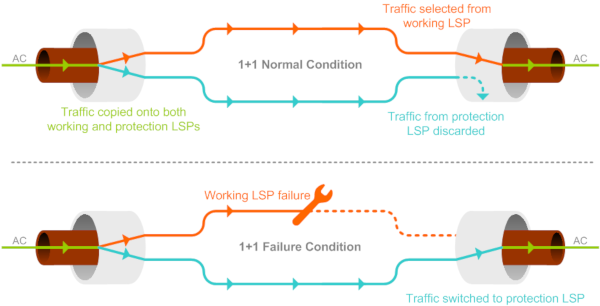G7860A supports both MPLS-TP and Carrier Ethernet (EPL, EVPL, EPLAN, EVC defined in MEF) for packet transportation. In addition to native Ethernet transport, G7860A can be used as the gateway for PDH and SDH/SONET networks to enter PSNs using Circuit Emulation and Encapsulation technologies. TDM encapsulation technologies of G7860A support TDMoE, TDMoIP, and TDMoMPLS, while Circuit Emulation technologies supported by G7860A are CESoPSN (Nx64K), SAToP (Unframed E1/T1), and CEP (SDH/SONET paths).
One G7860A with up to 85G packet switching capacity supports six 10GbE SFP+ and four 1GbE SFP built-in interfaces along with 16 E1/T1 built-in ports. With the two hot-swappable plug-in slots, the system capacity can be scaled up with additional E1/T1 ports, STM-n/OC-n, or GbE interfaces.
G7860A provides high availability and reliability required by Carrier, Power Utility, Military, Government and Transportation applications by supporting MPLS-TP LSP 1:1/1+1 protection with protection switching time smaller than 50ms, with section and end-to-end OAM for monitoring. The compact G7860A is only 1U height, but its powerful functions enable customers to construct a hub, ring, or mesh 10G packet network with ultimate ease.
Mechanical and Electrical
- 1U height, 19” width ETSI unit (front access)
- Power supply: hot swappable DC/AC, dual for redundancy
- Operating Temperature: -20 ºC to 65 ºC
System capacity
- Up to 6 x 10GbE SFP+ ports
- Up to 16 x 1GbE Base-T
- Up to 20 x 1GbE SFP
- Up to 80 x E1/T1 ports
- Up to 8 x STM-1/OC-3 ports or 2 x STM-4/OC-12 ports
- Up to 4 x STM-1/OC-3 MSP pairs or 2 x STM-4/OC-12 pairs
- 16 x E1/T1 ports with SCSI interface
MPLS-TP
- Any Ethernet port can be configured as NNI (MPLS port) or UNI (Ethernet service port)
- Bi-directional LSP
- Static LSP/PW provisioning via NMS
- Ethernet (VPWS, VPLS, H-VPLS) and TDM (CESoPSN, CEP, and SAToP) services
- MPLS-TP OAM and QoS
Carrier Ethernet
- L2 Switching/Bridging
- STP, RSTP, MSTP
- Port based VLAN and port isolation
- VLAN Stacking (Q-in-Q)
- CE OAM
- CFM: Ethernet Service OAM (802.1ag/Y1731)
- EFM: Ethernet Link OAM (802.3ah)
- Flow Control
- Link Aggregation Control Protocol (LACP)
- Jumbo Frame (MTU) = 9600
Network Protection
- MPLS-TP
- LSP 1+1/1:1
- LSP E2E protection switching < 50ms
- Based on TP OAM for fault detection
- Carrier Ethernet
- ELPS (G.8031) Linear Protection
- SDH/SONET
- STM-n/OC-n MSP 1+1 Protection
Management
- Fully manageable via SNMP (v1, v2, v3)
- Fully manageable via CLI
- Serial port
- SSH, Telnet via Ethernet
- GbE Interface in-bands
- Account Security
- Two types of privileges: Operator (read only) and Administrator (read and write)
- Radius Client Authentication
- Upload/Download NE configuration
- Syslog, NTP
TDM Services
- Circuit Emulation
- Fractional E1/T1 (64K timeslots): CES & multiframe PW
- Unframed E1/T1: SAToP PW
- VC-3/4/11/12, VT-1.5/2, STS-1/3: CEP PW
- PDH Timing recovery: ACR/DCR/System
- SDH Circuit Emulation over Packet (CEP)
- Encapsulation
- PW/LSP (TDM over MPLS-TP),
- “Dry martini”, MEF 8 (TDM over Ethernet),
- TDM over IP
Ethernet Services
- E-Line, E-LAN, E-Tree services as defined by MEF 9 and 14 and using VPWS/VPLS
- Native Ethernet packets supported
- Encapsulation: PW/LSP (MPLS-TP), VLAN tagging (1Q), VLAN double tagging (Q-in-Q)
VPLS
- VPLS bridging
- H-VPLS bridging
- 32K MAC addresses
- 2K VPLS instances per device
- Split horizon to prevent forwarding loops
CoS/QoS
- 8 Priority Queues
- Scheduling: Strict Priority, WRR with Hierarchy
- Ingress Policing & Egress Shaping per service
- CIR / PIR (EIR) 2-rate-3-color
- MPLS: TC/EXP-Inferred-PSC (Per Hop Behavior Scheduling Class) LSP
Timing
- SSM quality level compatible
- IEEE 1588 v2 (via SyncE only)
- PTP Clocks: Ordinary/Boundary/Transparent
- ToD (Time of day)
- 1-PPS (One Pulse per second) output interface
- SyncE
- Synchronous Ethernet from all built-in and plug-in GbE, 10GbE ports
- ITU-T Ethernet Synchronous Message Channel (ESMC)
- Stratum 3 timing
- TDM line clock: E1/T1
- External clock input and output (2 Mbps / 2 MHz)

In addition to native Ethernet traffic, TDM circuits including DS0 timeslots, E1/T1 channels, and SDH/SONET paths can all be emulated as packets via pseudowires, multiplexed by G7860A, and switched to different sites via packet networks.

Protection scheme of an MPLS-TP network is standardized as part of the protocol. By deploying static nodes in the network, traffic transported by a tunnel between remote ends is protected by two label switching paths (LSPs) to achieve 1:1 or 1+1 protection.
In 1+1 mode, traffic is copied onto both working and protection LSPs. When receiving traffic, the remote LER only selects traffic from one of the two LSPs to decapsulate.

In 1:1 mode, traffic flows only on the working LSP. When a failure occurs on the working LSP, traffic is then switched to the protection LSP within 50 ms.

RoHS compliant units are identified by the letter G appearing at the end of ordering code.
| Part Number |
Description |
Notes |
|
|
|